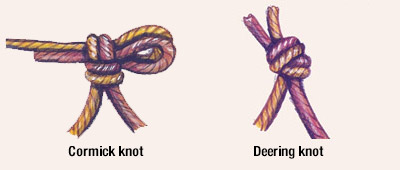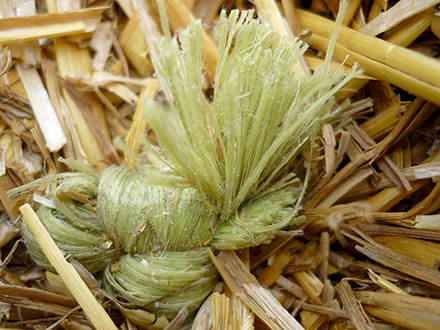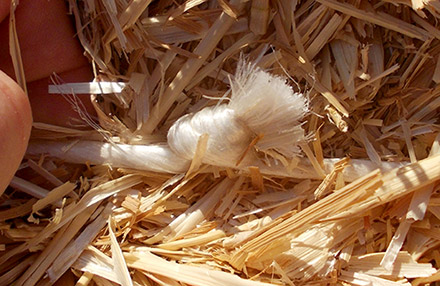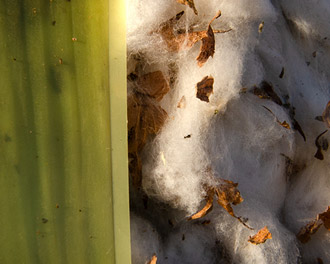The mystery of twine
2014
Strong string or smoke and mirrors…? Read more
Traditionally, big bale twine has two specific market users; those who make normal density big-bales, often where the straw is used as frost protection covering for root vegetables, typically using ‘Type 150’ twine. Others may make heavier bales where bale density is more important and maximum bale weight is needed if the bales are being transported, where the stronger ‘Type 130’ is the usual choice. Heavier and denser bales need stronger twine which, of course, means thicker twine. Both types of twine, 150 and 130, are made in the same size and weight 2-spool pack, so thicker twine obviously means less length in each pack, but the thicker twine is stronger. However, the baler operator also needs to re-load the baler more often.
Relative strength
A more accurate way of benchmarking the quality of a twine is to understand what is called the ‘Relative Strength’, where the efficiency of the twine yarn is measured as a factor of the Tensile Strength against the ‘real’ runnage (m/kg). In this way, it is possible to give a much clearer indication of one twine against another, important when choosing which twine to use in which baler.
Can you ever really know the ‘knot strength’ ?
An important point that many twine users may not appreciate is the type of knot that their baler makes actually has a critical impact on how strong the twine actually is in their machine.
 There are two distinctly different types of knots used in large square balers; the Cormick type knot and the Deering type knot.
There are two distinctly different types of knots used in large square balers; the Cormick type knot and the Deering type knot.


The ‘strength’ of knot made in a Cormick type of knotter will retain up to 70% or more of the tensile strength of the twine, the knot strength is higher because the angle between the twine and the knot is more open, due to the twines in the knot wrapping around a much greater surface area. Twine used in a Deering type of knotters will only be able to retain up to 55% of its tensile strength, the smaller surface area knot making the twine within it work as a knife against itself.
So, we can clearly say that the ‘strength’ properties of any twine will be different depending on which type of knotter it is being used in. This knowledge immediately changes the accuracy of the information a twine manufacturer quotes in their marketing literature, when stating the ‘knot strength’ of their twine.
Simply using a value called ‘knot strength’, without qualifications on which knot and what conditions it was tested, is definitely not the way do determine twine strength or quality. Without full details of which type of knot their twine was tested in and under what conditions, their numeric claims are worthless.
Real length per pack… or just a guess…?
For those who operate square balers, the method to categorise twine has always been the ‘type number’ reference, such as ‘Type 130’, for example. This ‘type number’ was originally intended to describe the runnage, or metres per kilogramme (m/kg) of the twine in the spool. This would have meant you could easily calculate the length of twine in the spool by simply weighing the spool, then dividing this by the stated metres/kilogramme, so giving the actual metres in the spool. This method would work well, as long as the stated runnage was an accurate and true reflection of the actual runnage.
Nowadays, however, this is not the case. No twine manufacturer describes his product with the ‘real’ runnage, so that there is no way of knowing exactly what you are buying ! For example ‘Type 130’, which one would expect to be 130metres for every 1kg of plastic, is typically only 115m/kg, meaning in every 2 x 9kg pack of twine you are actually getting 270m LESS twine than you would expect from the type of twine indicated. If the twine was truly 130m/kg, each 2-spool pack would contain 2,340m, but with runnage down to 115m/kg, the actual pack length is only 2,070m !
You have no idea exactly what you are buying.
How much twine…?
It is impossible to truly calculate how long a spool is from simply using it all up and then counting the bales, as one might do with a roll of netwrap. On Large Square balers, there are either 4 or 6 strings around the bale, which could make it straight-forward to calculate twine usage.
However, most popular machines are ‘double-knot’ balers, where each ‘string’ around the bale is made with twine from 2 separate spools. This means that, on the larger model balers, each bale requires 12 spools of twine to make ONE bale. The calculation of twine usage on ‘double-knot’ balers is then really complicated by the fact that of the two separate spools for each string, one runs only along the bale top, the other runs down the front, along the bottom and up the back of the bale, a far greater distance, so this spool will run out long before the other.
Now, try and calculate how many metres are in a spool by the bales made…! It’s impossible. Those manufacturers who are ‘cheating’ on the runnage (real runnage against the ‘stated’ runnage) have the perfect way to hide their actions…





